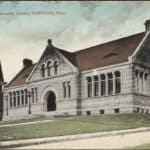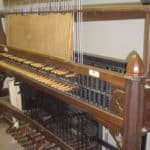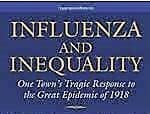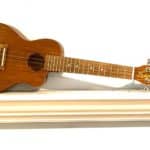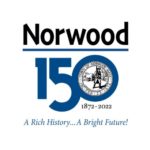
9
NovNorwood: A Home Town
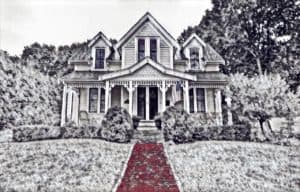 When we moved to Norwood in 2012, I was excited about owning a historic home that was within walking distance to both my work at the library and the town’s center. I wondered how many families had placed their hands on the sturdy wooden banister leading from the second floor. I imagined other women lovingly serving meals for family and guests in the spacious dining room. I was curious about the children and adults who might have peeked out the windows to watch passersby or wait for Halloween trick-or-treaters to knock on the distinctive double doors.
When we moved to Norwood in 2012, I was excited about owning a historic home that was within walking distance to both my work at the library and the town’s center. I wondered how many families had placed their hands on the sturdy wooden banister leading from the second floor. I imagined other women lovingly serving meals for family and guests in the spacious dining room. I was curious about the children and adults who might have peeked out the windows to watch passersby or wait for Halloween trick-or-treaters to knock on the distinctive double doors.
I wished there were photographs hidden in far reaches under the eaves of the deep closets, but there were not.
Working as a librarian certainly has its benefits because I knew just where to look to locate a bit of the house’s history and inhabitants. All of this information can be accessed by anyone who visits Norwood’s history collection in the Cushing Reading Room. Both the Annual Town Reports (now digitally available through the Minuteman Library Network catalog) and Norwood Street Lists are there for anyone to use to research.
Included on those history shelves (while under lock and key, the Adult Information Services librarians will be happy to help unlock them) are two volumes – Norwood: A Home Town. They are rich in architectural detail and structural information that was compiled by both the Norwood Historical Commission and the Massachusetts Historical Commission in the last two decades of the 20th Century. Hundreds of Norwood’s homes are listed by street address; pages that begin with Atwood Avenue and end with Winter Street. Most of the historical descriptions of the hundreds of homes were written by researcher Edward Gordon.
Norwood: A Home Town begins with details of the Town of Norwood’s districts and commercial buildings. Norwood Center, or “the hook,” the F. Holland Day House, the Winslow Brothers tannery complex are all described and illustrated. The town’s amazing presses, among them the Norwood Press and the Plimpton Press, are included. Of particular interest to me are the pages devoted to George H. Morrill & Co. Printing Ink Works. It was George Morrill who built Norwood’s library with his own funds, in memory of his daughter. Like Carnegie of the same era, Morrill shared his wealth and handed over the keys to the library to the town in 1898.
Morrill eventually moved his ink company out of Norwood and consolidated with four other ink companies. In 1945 the Geo. H Morrill Company Division of General Printing Ink Corp was renamed Sun Chemical Corporation.
In 2012, when I decided to research my new home on Prospect Street, I went to the Norwood: A Home Town and the Norwood Street Lists. 305 Prospect Street is listed merely as the Samuel Page House, named for its first owner. It was built in either the 1870s or 1880s on land purchased from the Fairbanks family. On a late 19th century map of Norwood (that can be found in the library’s map drawers), everything north of Prospect Street from Winter to Nahatan streets was illustrated as woods or farmland. This was truly the edge of Norwood’s town center just south of Westwood.
In 1989 the home included a barn in the rear which was removed sometime in the late 20th century. The actual date the house was built is unknown; there was a residence there in 1876, and Samuel Page was listed in the town’s Street Listing as residing there in 1880. However, there is a period when he was listed as living at 276 Prospect Street between 1897 and 1900. Whether mistakes were made, or Samuel moved out to rebuild his home after a fire destroyed the original is unknown.
The architectural character of the house, however, was of the 1880s and today might be thought of as hybrid, encompassing the Stick, Victorian and Queen Anne styles. What we might call Gingerbread is a particular characteristic with overlapping multiple-sided shingles and pretty trim. Perhaps Samuel built it over the years, finally inhabiting it with a family in 1900.
From the Town of Norwood’s Street Listings early in the 20th century, Lillian Page is listed as the resident of the house between 1908 and 1922. She is presumably Samuel’s daughter, or perhaps a younger wife. She left the home in 1922.
The 37-year period between 1922 and 1959 saw three families in the home, two of them staying only ten or eleven years each. Twenty-seven-year-old Joseph Youlden and his wife Dorothy, five years younger, might have raised their family there. Children under twenty were not listed in the Street Listings. In 1939 thirty-five-year-old Harry Fraser (a landscape architect) and his wife, Helen moved to Prospect Street from Highland Street – from perhaps a much smaller home that is not listed in the Norwood: A Home Town. In 1949 Raymond and Grace Rafuse, both in their fifties, moved from a house across from the Highland Cemetery on Winter Street. Their two working daughters lived with them, Gladys was born in 1920, and Jean was born in 1925.
It was in 1959 that John Payne moved into the home from Dedham and lived there for 41 years with his wife, Jeannette. For a time, a young nurse named Mary Orphan lived with them. There were several anecdotal stories about the Paynes – there were teenage daughters who had parties there. Jeannette died in 1988, and the home then lost its attentive care. It was in particularly neglected shape when a young hockey-minded couple from the area, Timothy and Anne Lovell, purchased it in 2001. They restored much of its charm and character, added a long brick walkway to the front porch, and renovated the kitchen and baths. They lived there with their four young children until 2012.
We loved living in such a sweet and gentle home in one of Norwood’s lovely neighborhoods and will miss much about the house, particularly its front and side porches. We watched lightning storms travel south as we rocked on our glider on the left front porch, hidden by the azaleas and Boxwood bushes. We admired joggers and dog walkers who took in their exercise every morning and night. From the private side porch off the kitchen, we sipped morning coffee, our feet propped on the white railing.
Approaching cars shown lights in our dining room windows as they turned the corner from Cottage Street heading east towards Dedham. Through open windows, we heard the sirens of Norwood’s most exceptional fire and police departments and listened to the faint sounds of concerts on the Town Common. In the wee morning hours near 4 am, we were sometimes sleepily awakened by the sound of the commuter rail’s train whistle.
Lucky for us, we will commute from our home on the South Coast to our jobs in Norwood, a Town in which we truly feel “at home.” If you want to know more about the houses in Norwood, visit the library’s historical collection in the Cushing Reading Room.
Charlotte Canelli is the Director of the Morrill Memorial Library in Norwood, Massachusetts. Read Charlotte’s column in the November 8, 2018 edition of the Norwood Transcript and Bulletin.

